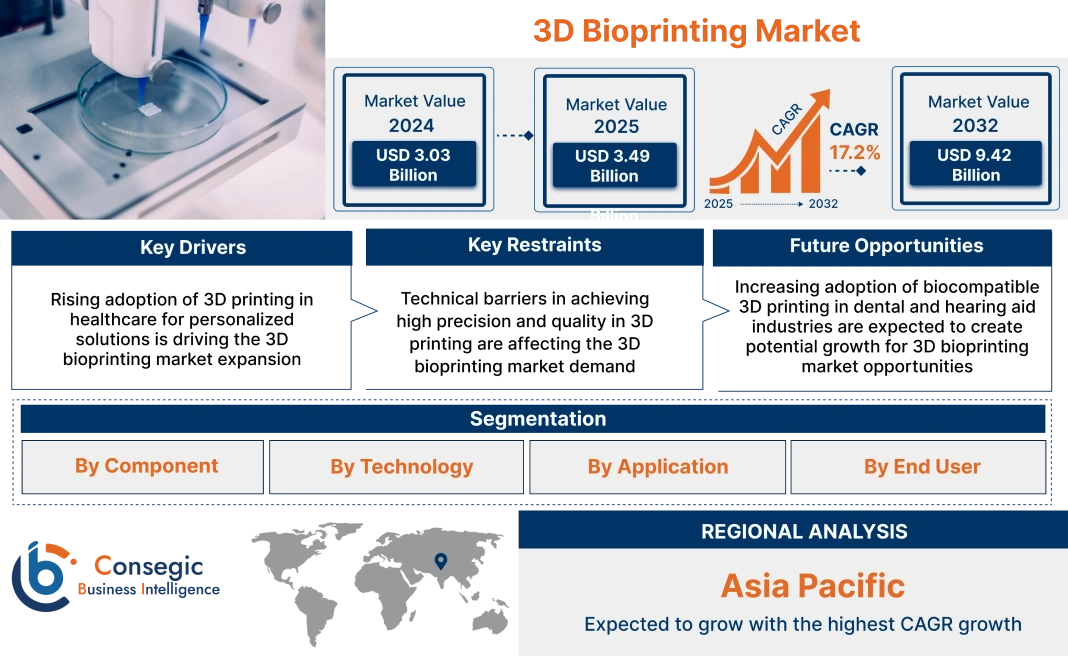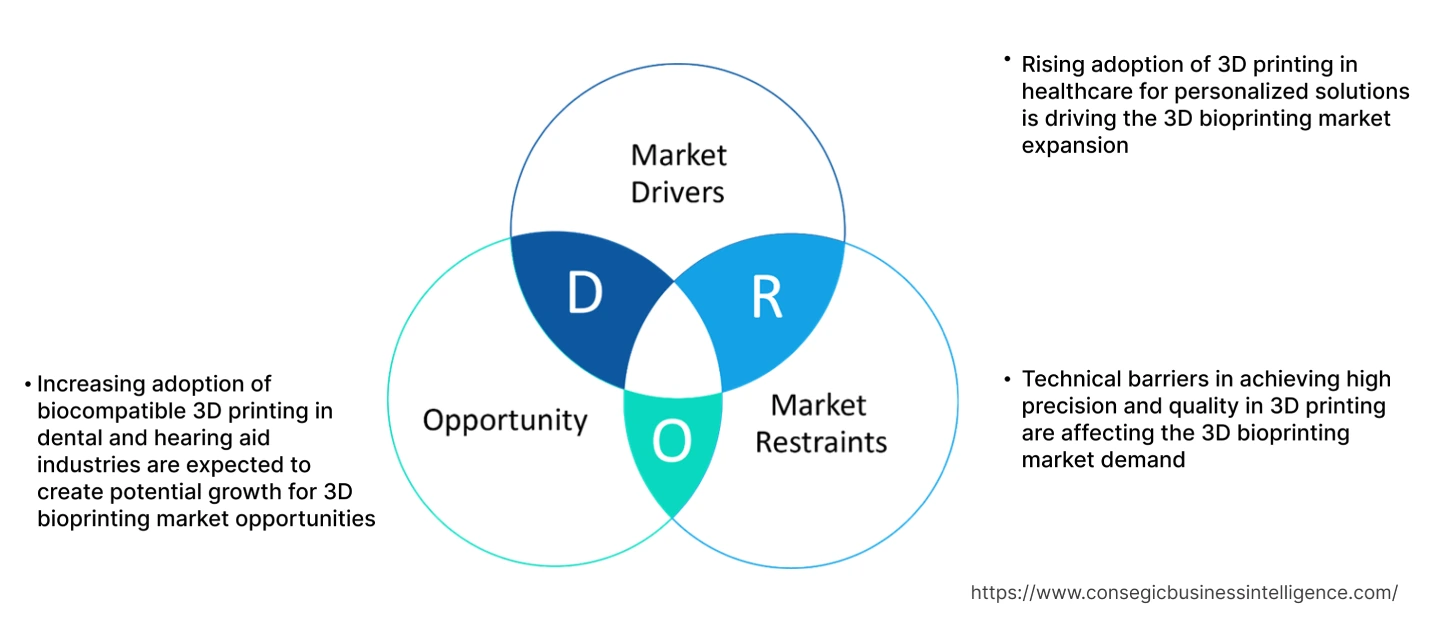3D Bioprinting Market Size:
3D Bioprinting Market Size is estimated to reach over USD 9.42 Billion by 2032 from a value of USD 3.03 Billion in 2024 and is projected to grow by USD 3.49 Billion in 2025, growing at a CAGR of 17.2% from 2025 to 2032.
3D Bioprinting Market Scope & Overview:
3D bioprinting uses layer-by-layer deposition of cells and biomaterials to create 3D structures like tissues and organs, with applications in tissue engineering, regenerative medicine, and drug discovery. Biocompatible 3D printing materials are crucial in creating medical implants, prosthetics, and other healthcare applications that require compatibility with human tissue. The integration of 3D printing technology with biocompatible materials has revolutionized the manner in which medical devices are designed and manufactured, offering significant benefits such as customization, reduced production time, and cost efficiency.
How is AI Transforming the 3D Bioprinting Market?
The utilization of AI is significantly transforming the 3D bioprinting market, particularly for enhancing various aspects of the process, including material optimization, process automation, and accelerating vascularization. Moreover, AI integration can automate tasks, predict optimal bioink compositions, and adjust printing parameters in real-time, which leads to more precise and efficient bioprinting. This integration of AI into bioprinting is further driving advancements in regenerative medicine and personalized healthcare.
Additionally, AI-powered automation streamlines bioprinting workflows, in turn minimizing errors and enhancing consistency. Therefore, the aforementioned factors are expected to positively impact the market growth in upcoming years.
3D Bioprinting Market Dynamics - (DRO) :
Key Drivers:
Rising adoption of 3D printing in healthcare for personalized solutions is driving the 3D bioprinting market expansion
The rising adoption of 3D printing in healthcare for personalized solutions is a significant driver in the global market. Personalized healthcare solutions, such as customized implants, prosthetics, and surgical guides, offer patients enhanced treatment outcomes and a better fit as compared to traditional, mass-produced devices. With 3D printing, medical professionals can design and create patient-specific products, improving the precision of treatments and reducing the risks of complications. This trend is particularly important in fields such as orthopedics, dentistry, and reconstructive surgery, where customized solutions are crucial for optimal recovery.
3D printing enables faster production times and cost-efficiency, which is a lucrative factor for healthcare providers. This shift towards personalized healthcare solutions driven by 3D printing technologies aligns with the growing trend of precision medicine, where treatments and devices are tailored to individual patient needs.
- For instance, in February 2025, Stratasys announced the collaboration with Siemens, to enable 3D printed medical imaging shades to replicate human anatomy. By combining Stratasys' specialized 3D printing materials and anatomical modeling software with Siemens' sophisticated image processing, the company has created shades that better mimic complex human anatomy. This advancement allows improved pre-surgical planning, research, and medical education.
Thus, according to the 3D bioprinting market analysis, the rising adoption of 3D printing in healthcare for personalized solutions is driving the 3D bioprinting market size.
Key Restraints:
Technical barriers in achieving high precision and quality in 3D printing are affecting the 3D bioprinting market demand
3D printing offers remarkable potential for producing customized medical solutions, however, the technology still faces challenges in achieving the level of precision required for certain applications. For instance, in the healthcare sector, when producing implants, prostheses, or surgical guides, the smallest deviation from the intended design can result in device malfunctions or complications for the patient.
Further, variations in the material composition, print speed, temperature, and other factors can lead to inconsistencies in the final product. This can affect the mechanical properties and biocompatibility of the printed devices, which are essential for their safety and effectiveness in medical applications. Thus, the aforementioned factors would further impact on the 3D bioprinting market size.
Future Opportunities :
Increasing adoption of biocompatible 3D printing in dental and hearing aid industries are expected to create potential growth for 3D bioprinting market opportunities
The increasing adoption of biocompatible 3D printing in the dental and hearing aid industries presents a significant prospect for the global market. In the dental industry, 3D printing is revolutionizing the way custom implants, crowns, bridges, and dentures are manufactured. Traditional methods of producing these dental products can be time-consuming and involve complex procedures. The ability to print complex structures with high accuracy, coupled with the use of biocompatible materials, ensures that the products are both functional and safe for long-term use. This increasing adoption is driving demand for biocompatible 3D printing solutions in dental practices.
Further in the hearing aid sector, the biocompatible 3D printing is making significant improvements in the customization of hearing aids and other auditory devices. With the ability to print personalized hearing aids, manufacturers can ensure a better fit for individual users, enhancing comfort and sound quality. Additionally, 3D printing offers opportunities to integrate more sophisticated designs and advanced features into hearing aids, such as improved ergonomics and miniaturization.
- For instance, in April 2025, researchers at the National University of Singapore (NUS) created a new way to produce custom gum tissue grafts. By using biocompatible 3D printing guided by artificial intelligence, the researcher made grafts tailored to individual patients. This technology aims to improve dental treatments by providing better solutions for repairing gum damage, resulting from gum disease or dental implant issues.
Thus, based on the above 3D bioprinting market analysis, the increasing adoption of biocompatible 3D printing in dental and hearing aid industries are expected to drive the 3D bioprinting market opportunities.
3D Bioprinting Market Segmental Analysis :
By Component:
Based on component, the market is segmented into 3D bioprinters and bioinks.
Trends in the Component:
- The improvements in resolution, print speed and the complexity of printable structures are facilitating the use of more complex and useful bio printed structures.
- Innovations in bioprinting technology, such as 3D bio printing and AI-assisted bioprinting, are improving the efficiency, speed, and quality of bioprinting processes, leading to increased adoption of advanced components.
- Thus, based on the above analysis, these factors are driving the 3D bioprinting market demand.
The 3D bioprinters segment accounted for the largest revenue share in the year 2024.
- The development of new and biocompatible materials, such as bioinks, is crucial for creating viable tissues and organs, in turn driving innovation in the 3D bioprinters.
- The investments in research and development, along with favorable regulatory frameworks, are accelerating the adoption of bioprinting technologies.
- The improvements in resolution, print speed, and the complexity of printable structures are enabling more complex and useful bio printed structures.
- For instance, in June 2024, Tethon 3D launched new Bison Bio DLP 3D printer. Bison Bio is a compact, benchtop 3D bio printing system tailored for medical research and development. It is designed to work specifically with Tethon GelMA hydrogel bioink and Tethon LAP photo initiator.
- Thus, based on the above analysis, these factors are further driving the 3D bioprinting market growth.
The bioink segment is anticipated to register the fastest CAGR during the forecast period.
- Progress in bioprinting techniques, such as extrusion-based, inkjet-based, and laser-assisted bioprinting, necessitates the development of compatible and high-quality bioinks.
- The ability to create increasingly complex and precise tissue structures at the microscale is driving the demand for bioinks with tailored properties.
- The development of hybrid bioinks, which combine different materials to enhance mechanical strength and biocompatibility, is further fueling the global market.
- For instance, in March 2025, researchers at NIT Rourkela have engineered a new material bioink, which can be used in 3D bioprinters to create structures that resemble bone. This bioink made from a combination of natural and synthetic materials, aims to provide a better alternative to current bone repair techniques, such as bone grafting and metal implants, which often have drawbacks.
- Thus, based on the above analysis and developments, these factors are expected to drive the 3D bioprinting market share during the forecast period.
By Technology:
Based on the technology, the market is segmented into magnetic levitation, inkjet-based, syringe-based, laser-based, and others.
Trends in the technology:
- Rising advancements in tissue engineering, where 3D-printed scaffolds and structures are used to support the development of new tissues or organs, offering promising solutions for organ transplantation and repair.
- As consumer expectations for personalized, high-quality products rise, 3D printing offers the ideal solution by enabling mass customization with high precision.
The inkjet-based segment accounted for the largest revenue share of 41.97% in the year 2024.
- Inkjet technology excels in handling variable data and designs with minimal setup time, making it ideal for producing short runs economically and efficiently. This flexibility not only reduces inventory overheads but also empowers businesses to explore new revenue streams through niche markets and specialty products.
- This technology enables the creation of intricate, living tissues or organs by depositing biological materials, known as bio-inks, onto a growth surface.
- The ongoing research and development are improving the precision, speed, and resolution of inkjet bioprinting, making it an increasingly attractive option for various applications in tissue engineering and regenerative medicine.
- Thus, these factors would further supplement the 3D bioprinting market
The magnetic levitation segment is anticipated to register the fastest CAGR during the forecast period.
- Magnetic levitation offers a simple, cost-effective, and precise method for separating and suspending diverse materials, including biological samples, without the need for labels or external electricity.
- By leveraging sophisticated capabilities, enhanced speed, and greater accuracy, magnetic levitation minimizes bioprinting inaccuracies by more than 80%.
- These developments in the magnetic levitation segment are anticipated to further drive the 3D bioprinting market trends during the forecast period.
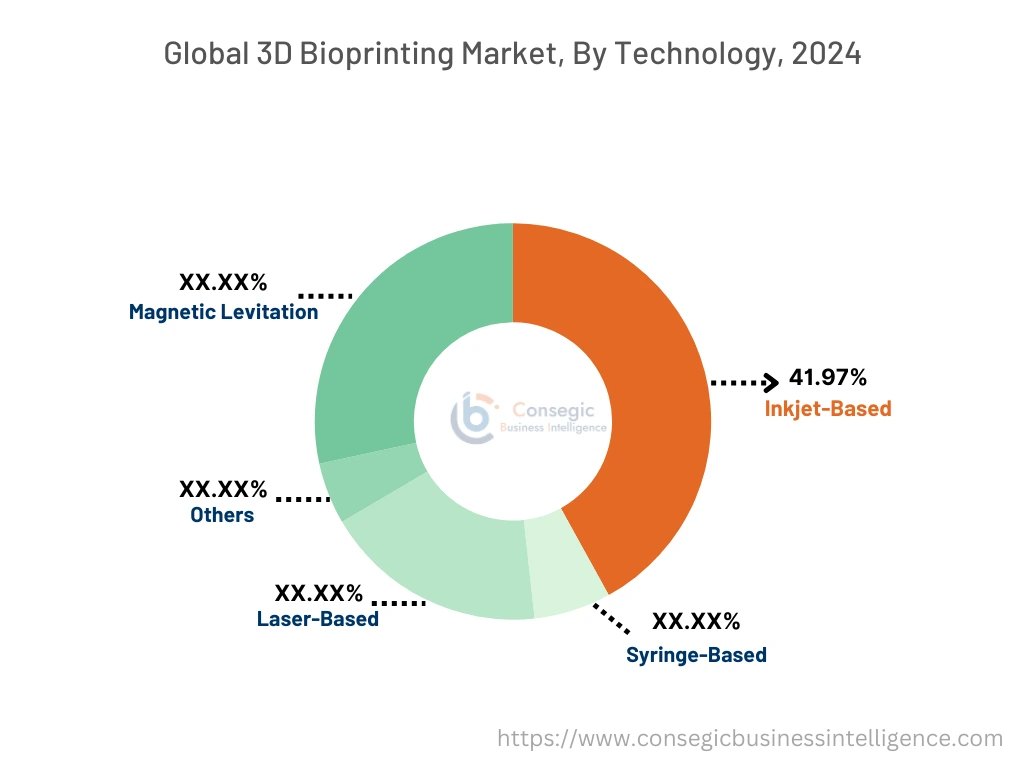
By Application:
Based on application, the market is segmented into research applications and clinical applications.
Trends in the application:
- The bioprinting allows the creation of complex tissue models that mimic human diseases, facilitating research on disease mechanisms and development of new therapies.
- The bioprinting enables precise customization of implants, potentially improving surgical outcomes and reducing complications.
The research applications segment accounted for the largest revenue in the year 2024.
- The ongoing research focuses on developing bioinks with improved printability, cell viability, and tissue-like properties, enabling the creation of more complex and functional structures.
- For research and development, AI algorithms and automated systems are being used to optimize the bioprinting process, improve cell viability, and design complex structures.
- The increasing prevalence of chronic diseases and injuries drives the need for biocompatible 3D printing in regenerative medicine, leading to increased research and development in this sector.
- Thus, based on the above developments, these factors are driving the 3D bioprinting market growth.
The clinical applications segment is anticipated to register the fastest CAGR during the forecast period.
- The continuous progress in materials science, bioengineering, and computer science is fuelling the development of new and improved bioprinting technologies for clinical applications.
- The advancements in bioprinting techniques, such as inkjet, extrusion, and laser-assisted bioprinting, enable the creation of more complex and functional structures for clinical applications.
- The bioprinting also enables the creation of patient-specific models for surgical planning, and improving surgical precision and outcomes.
- These factors are anticipated to further drive the 3D bioprinting market trends during the forecast period.
By End User:
Based on end user, the market is segmented into research organizations and academic institutes, biopharmaceutical companies, and hospitals.
Trends in the end user:
- The development of more sophisticated bioinks is crucial. Researchers are creating bioinks that better mimic the natural extracellular matrix, improving tissue function and integration. This includes research into using patient-derived cells, to reduce rejection of implanted bioprinted materials.
- The segment development can be attributed to the growing demand for automated bioprinting systems and processes for producing large quantities of tissues and organs.
The biopharmaceutical companies segment accounted for the largest revenue share in the year 2024 and it is expected to register the highest CAGR during the forecast period.
- Major players such as Roche and AstraZeneca are actively investing and utilizing biocompatible 3D printing for drug development and research.
- Biopharmaceutical companies are investing in the development of increasingly complex tissue models that mimic the intricate structure and function of human tissues. This includes the creation of vascularized tissues and organoids that reflect in vivo conditions more accurately.
- For instance, in January 2021, CELLINK announced the collaboration with AstraZeneca, to assist in validating respiratory tissue models using bioprinting applications. CELLINK will provide the advanced bioprinting technology to aid in the discovery of new treatments and the study of disease pathways within AstraZeneca's key research areas including cancer, respiratory and immune system disorders, and heart, kidney, and metabolic conditions.
- Thus, based on the above factors, these developments are driving the global market trends.
Regional Analysis:
The global market has been classified by region into North America, Europe, Asia-Pacific, Middle East & Africa, and Latin America.
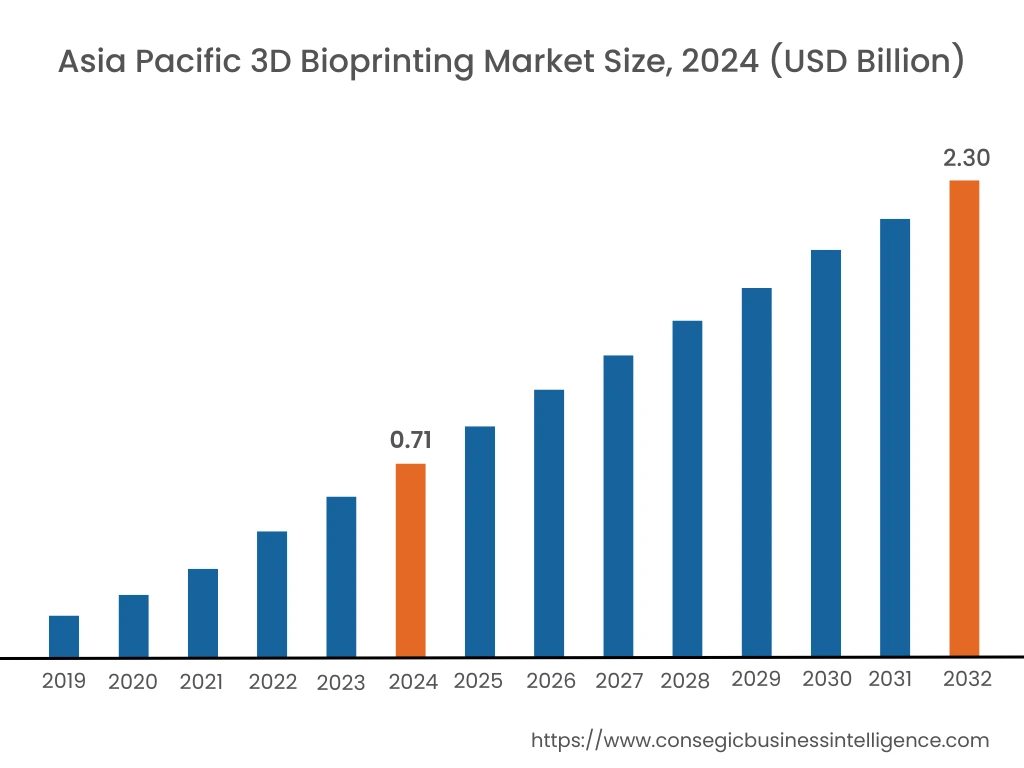
Asia Pacific 3D bioprinting market expansion is estimated to reach over USD 2.30 billion by 2032 from a value of USD 0.71 billion in 2024 and is projected to grow by USD 0.82 billion in 2025. Out of this, the China market accounted for the maximum revenue split of 36.41%. The rapidly improving healthcare facilities, increasing healthcare expenditure, and growing awareness of biocompatible 3D printing technology are key factors driving the market in the region. Asia-Pacific countries are significantly investing in healthcare infrastructure and technological advancements. Further, the rising geriatric population and increasing prevalence of chronic diseases further contribute to the demand for biocompatible 3D-printed medical devices in the Asia Pacific region. These factors would further drive the regional 3D bioprinting market during the forecast period.
- For instance, in November 2024, the Sree Chitra Tirunal Institute for Medical Sciences and Technology (SCTIMST) successfully created and patented India's first domestically developed bioink. This innovative material allows biocompatible 3D printing of various human tissues, including vital organs such as the liver, kidney, and heart, as well as skin and brain tissue.
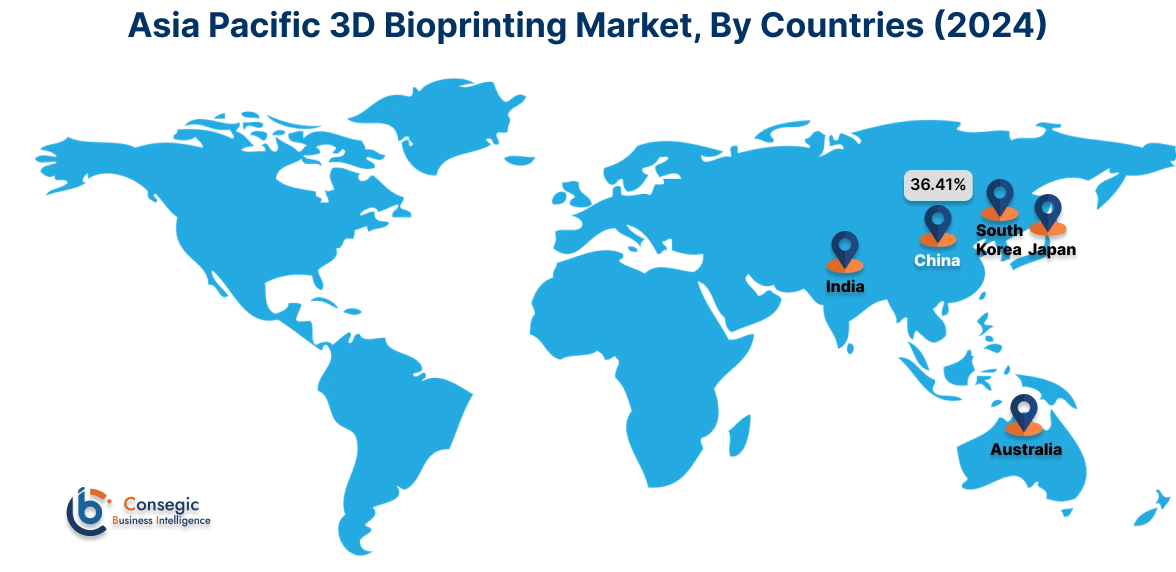
North America market is estimated to reach over USD 3.60 billion by 2032 from a value of USD 1.16 billion in 2024 and is projected to grow by USD 1.34 billion in 2025. The presence of advanced healthcare infrastructure, high adoption of innovative technologies, and significant investment in research and development activities are key factors contributing to the market dominance of North America. The United States is a major contributor to the growth of this market, driven by the strong presence of leading 3D printing companies and research institutions. Further, the adoption of advanced medical technologies, including biocompatible 3D printing, is on the rise in the region. Companies can capitalize on these prospects by establishing a presence in these markets and offer innovative solutions tailored to the specific needs of the region. These factors would further drive the market in North America.
- For instance, in May 2024, Scientists at Mayo Clinic employed 3D bioprinting technology to create realistic tissue models, allowing in-depth studies of damaged or diseased body parts. This technology provides a platform to investigate how diseases progress and to test the effectiveness of new treatments for conditions such as organ failure, cartilage damage, and eczema.
According to the analysis, the 3D bioprinting industry in Europe is anticipated to witness significant development during the forecast period. The region's well-established healthcare system, high healthcare expenditure, and focus on technological advancements are driving the adoption of biocompatible 3D printing in the region.
Additionally, the growing demand for personalized medical solutions and the increasing prevalence of chronic diseases further fuel market growth in the European region. Moreover, researchers and manufacturers are continuously working on creating materials that offer better biocompatibility, mechanical strength, and bioactivity. The development of such advanced materials can open up new applications and improve the performance of 3D-printed medical devices, driving the Latin America market growth. Further, pharmaceutical companies in the Middle East and African regions are increasingly adopting magnetic levitation 3D bioprinting technologies to enhance their drug discovery and development processes. The ability to create accurate tissue models for testing new drugs is a significant advantage, as it allows for more reliable and efficient preclinical testing.
Top Key Players and Market Share Insights:
The global 3D bioprinting market is highly competitive with major players providing solutions to the national and international markets. Key players are adopting several strategies in research and development (R&D), product innovation, and end-user launches to hold a strong position in the market. Key players in the 3D bioprinting industry include-
- EnvisionTEC, Inc. (U.S.)
- Organovo Holdings, Inc. (U.S.)
- Inventia Life Science PTY LTD (U.S.)
- Poietis (France)
- Vivax Bio, LLC (U.S.)
- Allevi (U.S.)
- Cyfuse Biomedical K.K. (Japan)
- 3D Bioprinting Solutions (Russia)
- Cellink Global (Sweden)
- Regemat 3D S.L. (Spain)
3D Bioprinting Market Ecosystem:
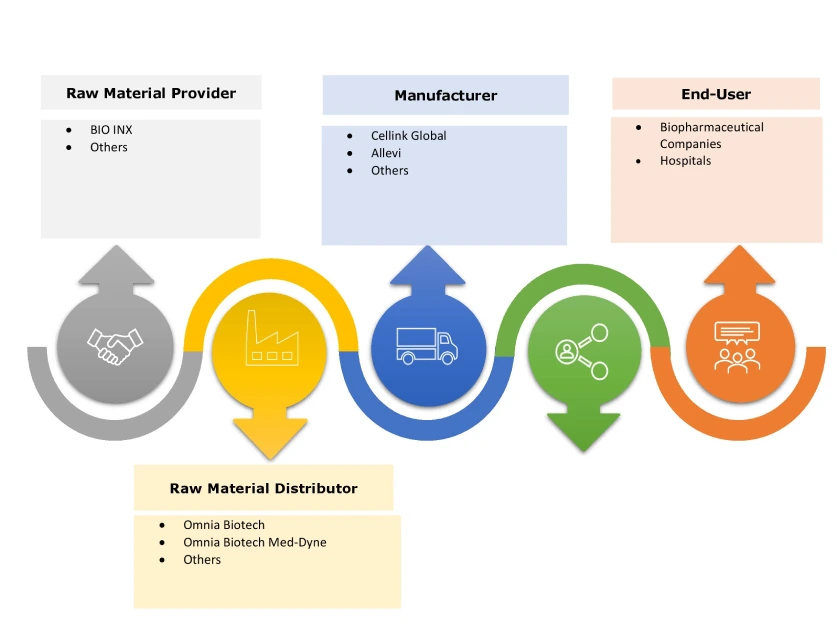
Recent Industry Developments :
Partnership:
- In December 2022, Cellink announced collaboration with Indian Institute of Science (IISc), to develop 3D Bioprinting Center of Excellence in India. The Center of Excellence (CoE) will offer researchers access to advanced 3D bioprinting technology. This access aims to speed up research across various crucial applications, ultimately leading to better patient health.
3D Bioprinting Market Report Insights :
| Report Attributes | Report Details |
| Study Timeline | 2019-2032 |
| Market Size in 2032 | USD 9.42 Billion |
| CAGR (2025-2032) | 17.2% |
| By Component |
|
| By Technology |
|
| By Application |
|
| By End User |
|
| By Region |
|
| Key Players |
|
| North America | U.S. Canada Mexico |
| Europe | U.K. Germany France Spain Italy Russia Benelux Rest of Europe |
| APAC | China South Korea Japan India Australia ASEAN Rest of Asia-Pacific |
| Middle East and Africa | GCC Turkey South Africa Rest of MEA |
| LATAM | Brazil Argentina Chile Rest of LATAM |
| Report Coverage |
|
Key Questions Answered in the Report
How big is the 3D Bioprinting Market? +
3D Bioprinting market size is estimated to reach over USD 9.42 Billion by 2032 from a value of USD 3.03 Billion in 2024 and is projected to grow by USD 3.49 Billion in 2025, growing at a CAGR of 17.2% from 2025 to 2032.
Which is the fastest-growing region in the 3D Bioprinting Market? +
Asia-Pacific region is experiencing the most rapid growth in the market.
What specific segmentation details are covered in the 3D Bioprinting report? +
The 3D bioprinting report includes specific segmentation details for component, technology, application, end user, and region.
Who are the major players in the 3D Bioprinting Market? +
The key participants in the market are EnvisionTEC, Inc. (U.S.), Organovo Holdings, Inc. (U.S.), Inventia Life Science PTY LTD (U.S.), Poietis (France), Vivax Bio, LLC (U.S.), Allevi (U.S.), Cyfuse Biomedical K.K. (Japan), 3D Bioprinting Solutions (Russia), Cellink Global (Sweden), Regemat 3D S.L. (Spain), and others.
